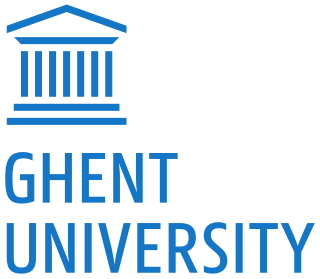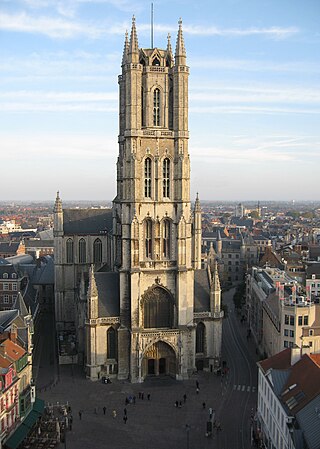History
In 1933 the famous Flemish architect Henry van de Velde (1863–1957) was commissioned to design a building for the Library and the Institutes of Art History, Veterinarian Studies and Pharmaceutical sciences of the Ghent University (Universiteit Gent) on the premises of the former De Vreese Alley on the Blandijnberg. Situated on the highest ground in the city, the site offered the architect a unique opportunity to give to Ghent its fourth tower, not for the ringing of bells this time, but for books. With its height of 64 metres (210 ft), the book tower reaches out to the sky above Ghent alongside its (late) mediaeval predecessors to mark the city skyline and to put the university visibly on the map. Together with the 3 towers, the so-called "Tower of Wisdom" helped Ghent realising the dream the town had since it hosted the World's Fair in 1913 of creating a "Parade of Towers". The famous three towers of the Middle Ages: the Saint-Nicolas Church, the Belfry and the Saint Bavo Cathedral and the modernist Booktower.
Constructed in concrete – an innovation in those days – using the then equally innovative technique of sliding shuttering, the tower was given the shape of a Greek cross to symbolize the connection between time and space, and merging heaven and earth. Twenty storeys above and four below ground level accommodate a line-up of some 46 kilometres of printed material, or over 3 million items. Supporting the vertical lines of the tower and the books on the shelves are the horizontal lines of the open books on the long tables of the magnificent reading-room, the rectangular courtyard that bathes in daylight, and the reading-room for manuscripts, safely shielded from daylight at the north side of the edifice. The tower was inaugurated in 1942 and recognized as a monument in 1992.
Restoration
Almost 70 years after its completion, a thorough restoration started, including the famous Belvedère and the gorgeous interiors. The occasion, however, is also used to make the tower more accessible to the general public. On the other hand, the building will be made to meet the demands of modern library management, especially as far as protection and management of the collection (air conditioning, replacement of obsolete by modern and more efficient provisions) are concerned. The tower will, therefore, not only be restored, but also thoroughly updated. A three floor underground repository is built under the inner garden; it will be completed in 2014 so the books can move from the tower to the underground and the concrete skin of the tower can be replaced. The entire operation is the work of a team around the architects Robbrecht and Daem. Restoration started in 2012. The library services with its study landscape and reading room returned to use in summer 2021. The east wing with office spaces was completed in early 2024 and works on the west wing were started in the same year.
The restoration began with the private person Andre Singer who initiated a campaign to make the university aware of the great architectural value of the building, and of the need of restoration. The then rector Andre De Leenheer, took on the difficult job of finding University money and other funding for the full restoration.
Trivia
During World War II the tower was taken over by the German Army because of its views of the surrounding area.
The Booktower houses about 46 kilometers of books and other material.
In 2007 the Flemish Television Centre VRT has nominated the belvedère of the book tower for their program "Monumentenstrijd". This "Battle between Monuments" was based on the popular BBC show Restoration, which had many viewers in Belgium (a belvedère – an observation post on the roof with an immense panorama – functions as a popular feature in large-scale public buildings.)
On the 3rd of April 2013 the Booktower figured in the Google logo to celebrate the 150th birthday of Henry van de Velde.
On November 12, 2018, a bronze dog was placed on top of the Book Tower. The animal looks east, towards the rising sun. The full-size, upright sitting dog is clearly visible from St. Peter's Square. It is an idea by Michiel Hendryckx that should stimulate both curiosity and amazement. The animalier Greta Van Puyenbroeck created the unique image for which a smooth-haired fox terrier served as a model.

Ghent is a city and a municipality in the Flemish Region of Belgium. It is the capital and largest city of the East Flanders province, and the third largest in the country, after Brussels and Antwerp. It is a port and university city.

Ghent University is a public research university located in Ghent, Belgium.

Henry Clemens van de Velde was a Belgian painter, architect, interior designer, and art theorist. Together with Victor Horta and Paul Hankar, he is considered one of the founders of Art Nouveau in Belgium. He worked in Paris with Siegfried Bing, the founder of the first gallery of Art Nouveau in Paris. Van de Velde spent the most important part of his career in Germany and became a major figure in the German Jugendstil. He had a decisive influence on German architecture and design at the beginning of the 20th century.

The Flemish Diamond is the Flemish reference to a network of four metropolitan areas in Belgium, three of which are in the central provinces of Flanders, together with the Brussels-Capital Region. It consists of four agglomerations which form the four corners of an abstract diamond shape: Brussels, Ghent, Antwerp and Leuven.

The Belfry of Ghent is one of three medieval towers that overlook the old city centre of Ghent, Belgium; the other two belonging to Saint Bavo Cathedral and Saint Nicholas' Church. Its height of 91 metres (299 ft) makes it the tallest belfry in Belgium. The belfry of Ghent, together with its attached buildings, belongs to the set of Belfries of Belgium and France, a UNESCO World Heritage Site.

St. Nicholas Church is one of the oldest and most prominent landmarks in Ghent, Belgium. Begun in the early 13th century as a replacement for an earlier Romanesque church, construction continued through the rest of the century in the local Scheldt Gothic style. Typical of this style is the use of blue-gray stone from the Tournai area, the single large tower above the crossing, and the slender turrets at the building's corners.
Science and technology in Flanders, being the Flemish Community and more specifically the northern region of Belgium (Europe), is well developed with the presence of several universities and research institutes. These are strongly spread over all Flemish cities, from Kortrijk and Bruges in the Western side, over Ghent as a major university center alongside Antwerp, Brussels and Leuven to Hasselt and Diepenbeek in the Eastern side.

Ghent University Library is a university library located in the city of Ghent, Belgium. It serves the Ghent University community of students and scholarly researchers.
Christine Conix is a Belgian architect whose projects have been described as innovative and diverse and creative. She created her firm Conix Architects in 1979 in the Antwerp city of Wilrijk; by 2007, her firm employed 67 people and by 2014, it had offices in Brussels, Warsaw, Rotterdam, Terneuzen, with the head office in Antwerp. In 2013, Conix architects won a contract to rebuild a Moroccan city named Nador to transform it into a center for economics and tourism, which involves constructing critical infrastructure such as houses, schools, and hospitals. Conix Architects designed a renovation and expansion for the Atomium in Belgium, a structure originally built for the 1958 World's Fair in Brussels. It designed the Belgian pavilion at the World Expo in Shanghai in 2010. Her firm won a contest among 28 architectural firms agencies for architectural work relating to the Vrije Universiteit Brussel. Conix believes intuition should play a large role in architectural design, and believes in sustainability, and sees no significant difference between men and women today in the field of architecture. She studied architecture at the Hoger Instituut voor Architectuurwetenschappen Henry van de Velde in Antwerp.

Saint Bavo's Cathedral, also known as Sint-Baafs Cathedral, is a cathedral of the Catholic Church in Ghent, Belgium. The 89-meter-tall Gothic building is the seat of the Diocese of Ghent and is named for Saint Bavo of Ghent. It contains the well-known Ghent Altarpiece.

Sint-Barbaracollege in Ghent, Belgium, is a public Jesuit school, founded in 1833. It currently includes primary and secondary education.

The Blandijn, short for Blandijnberg, is a building complex of Ghent University in the Belgian city Ghent and directly adjacent to Boekentoren, the tower of the Ghent University Library. The Blandijn, named after the Blandijnberg hill it stands on, houses the Faculty of Arts & Philosophy. The first part of the Blandijn buildings was officially opened in 1960. The Blandijn complex is located centrally in Ghent's student neighborhood. There are several other university buildings within walking distance of the Blandijn.

The Blandijnberg is a 29m high hill in the city center of Ghent in East Flanders, Belgium.

St John Berchmans University College, locally known as Jezuietenhuis or Lerkeveld, is an educational institution run by the European Low Countries Province of the Society of Jesus in Heverlee, outside Leuven. It was built in 1958 by Jos Ritzen, who worked with Alphons Boosten. It began as a philosophy and theology college for the Jesuits and housed their archives.

The Ghent City Museum is a museum in the Belgian city of Ghent. The museum exposes the city history and opened its doors on 9 October 2010. With respect to the collection that is shown, the history of this museum goes back to 1833, the year in which the Oudheidkundig Museum van de Bijloke in Ghent was founded. In 1928 the museum was situated in the Bijloke abbey - this led to the name Bijlokemuseum.

Design Museum Gent is a museum in Belgium with an international design collection. The museum complex is located in the tourist centre of Ghent and comprises an 18th-century mansion and a modern wing. The museum holds a collection of Belgian design, supported by international objects.

The Sint-Pietersplein is a city square located in the south of the historic centre of Ghent, East Flanders, Belgium. The square is named after St. Peter's Abbey, which is located along its east side. It is Ghent's largest public square and a regular venue for cultural and sporting events, such as the annual Mid-Lent Fair in March. The square and its surrounding buildings are a protected cityscape.

The Vrijdagmarkt is a city square in the historic centre of Ghent, East Flanders, Belgium. It is named after the weekly tradition to stage a market every Friday morning. As one of the oldest squares in Ghent, it played an important role in the city's history.
Antoine Philippe De Schryver (1924–2005) was a Belgian art historian and professor at the University of Ghent, where he lectured on History of Book Illumination. He was specialized in the field of illuminated manuscripts in the Southern Netherlands, 15th century painting, and artists at the Burgundian Court.






















